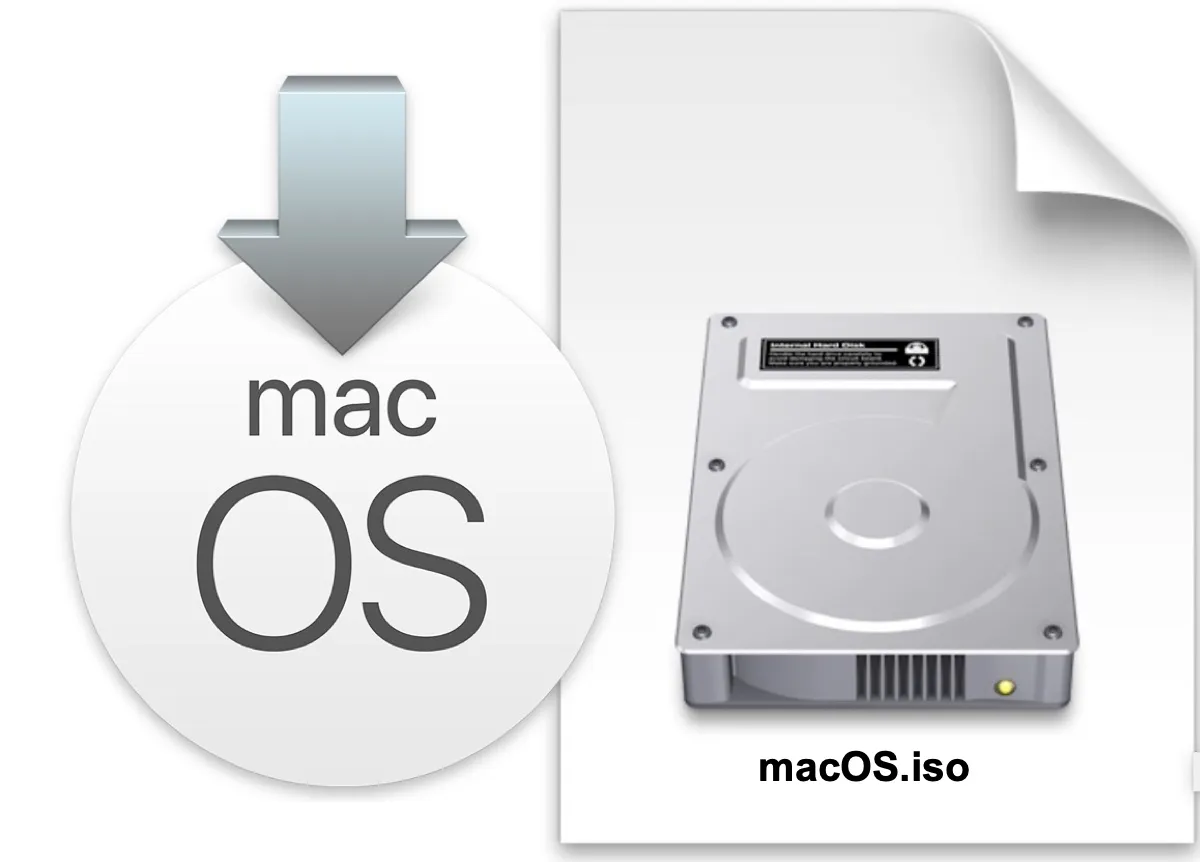🚀 Summarize this content with AI:
🤖 ChatGPT 🧠 Perplexity 🔍 Google AI Mode ⚡ Grok
Downloading macOS ISO files is often required for creating virtual machines, installing macOS on non-Apple hardware for testing, or preparing bootable installation media. However, Apple does not officially provide macOS ISO files for direct download, which makes many online ISO sources unreliable or unsafe.
This guide explains the safest and most practical ways to get macOS ISO files, with a strong focus on official sources, verified creation methods, and an easier alternative using iBoysoft DiskGeeker.
There are two situations where macOS ISO makes sense:
- 1) You want to run macOS inside a virtual machine.
- 2) You need an ISO to create a bootable macOS USB installer.
If that's not your case, stop here.
Downloading an ISO will waste your time.
⚠️ Important Notice Before Downloading macOS ISO Files
Many websites claim to offer "direct macOS ISO downloads." These files are often:
- Modified or outdated
- Unverified and potentially unsafe
- Missing security updates
- In violation of Apple's distribution policies
We strongly recommend using official Apple installers and creating ISO files yourself or using a trusted tool that automates the process safely.
The Safest Way to Get macOS ISO Files (Recommended)
Method 1: Download macOS ISOs Using iBoysoft DiskGeeker (Easiest & Safest)
- This method works if:
- ✅ You want to download a macOS ISO file safely on a Windows PC.
- ✅ You're willing to download the macOS DMG file on a Mac and then convert it into an ISO.
- ✅ You want to create a macOS bootable USB installer easily.
iBoysoft DiskGeeker provides a built-in macOS download feature that allows users to:
- Download official macOS installers directly from Apple servers.
- Choose from multiple macOS versions.
- Avoid broken or unsafe third-party ISO sources.
- Download macOS ISO files and create macOS bootable USB installers on a Windows PC.
- Prepare installers for further ISO creation or bootable media on a Mac.
Why this method is recommended:
- Uses Apple's official distribution channels
- No Terminal commands required
- Ideal for beginners and advanced users
- Eliminates the risk of corrupted or modified installers
macOS Versions Available for Download:
| macOS Version | Release Year | Recommended Use |
| macOS Tahoe | 2025 | Latest testing & VMs |
| macOS Sequoia | 2024 | Latest testing & VMs |
| macOS Sonoma | 2023 | Modern Macs & VMs |
| macOS Ventura | 2022 | Broad compatibility |
| macOS Monterey | 2021 | Stable VM setups |
| macOS Big Sur | 2020 | Intel & Apple Silicon |
| macOS Catalina | 2019 | Legacy software support |
| macOS Mojave | 2018 | Older Macs |
| macOS High Sierra | 2017 | Older Macs |
| macOS Sierra | 2016 | Older Macs |
| OS X Mavericks | 2015 | Older Macs |
| OS X Mavericks | 2014 | Older Macs |
| OS X Lion | 2013 | Older Macs |
| OS X El Capitan | 2012 | Older Macs |
| OS X Yosemite | 2011 | Older Macs |
| Mac OS X Snow Leopard | 2010 | Older Macs |
On a Mac, you can download the macOS installer and then convert it into an ISO file for virtual machines or deployment. Follow the steps below:
Step 1. Free download and open iBoysoft DiskGeeker for Mac.
Step 2. Select an internal partition and click Download Image. 
Step 3. Select the macOS version you want and click Get. 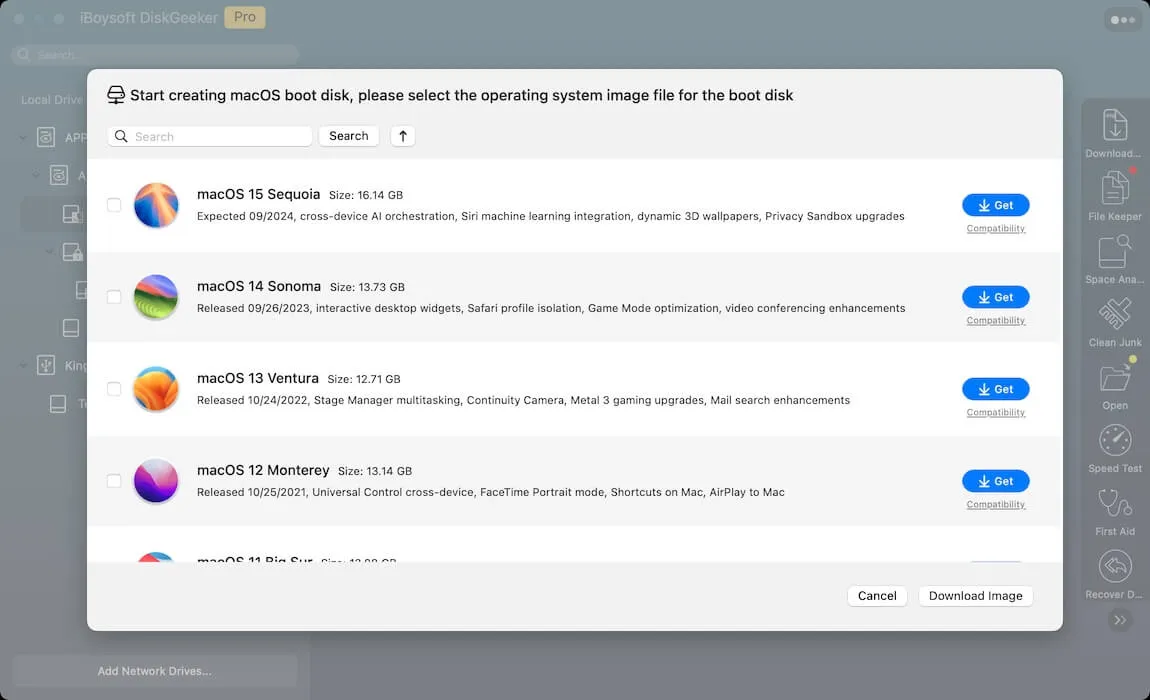
Step 4. After the file is downloaded, open Terminal.
Step 5. Run the hdiutil command below to convert the .dmg file to a .cdr file. (Remember to replace dmg_file_path with the actual path and xxx with the macOS version name.)hdiutil convert dmg_file_path -format UDTO -o ~/Desktop/xxx.cdr 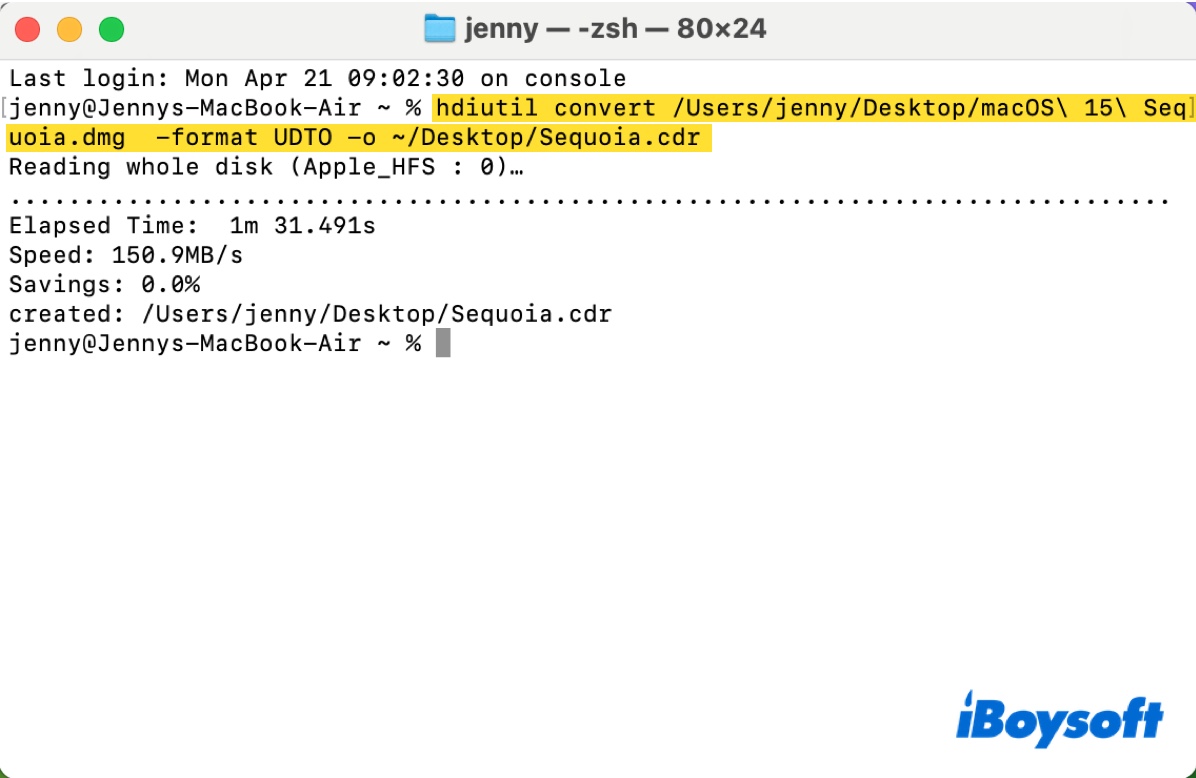
Type hdiutil convert, leave a space, then drag and drop the .dmg file to Terminal to get its file path, then leave a space, copy and paste -format UDTO -o ~/Desktop/xxx.cdr into Terminal, and hit Enter. The final command may look like: hdiutil convert /Users/jenny/Desktop/macOS\ 15\ Sequoia.dmg -format UDTO -o ~/Desktop/Sequoia.cdr
Step 6. Rename the .cdr file to an .iso file.mv cdr_file_path ~/Desktop/Sequoia.iso 
Type mv, leave a space, then drag and drop the .cdr file to Terminal to get its file path, leave a space, then type in ~/Desktop/xxx.iso and press Enter. The final command may be similar to: mv /Users/jenny/Desktop/Sequoia.cdr ~/Desktop/Sequoia.iso
Step 7. Find the macOS ISO file on your desktop.
Share this tool to help others download the macOS, OS X, or Mac OS X ISO file!
On a Windows PC, you can download the macOS ISO file directly and then use it for virtual machines, installing macOS on a PC, or creating a macOS bootable installer on Windows.
Step 1: Download, install, and open iBoysoft DiskGeeker for Windows.
Step 2: Open Download and create boot disk > Download macOS system image.
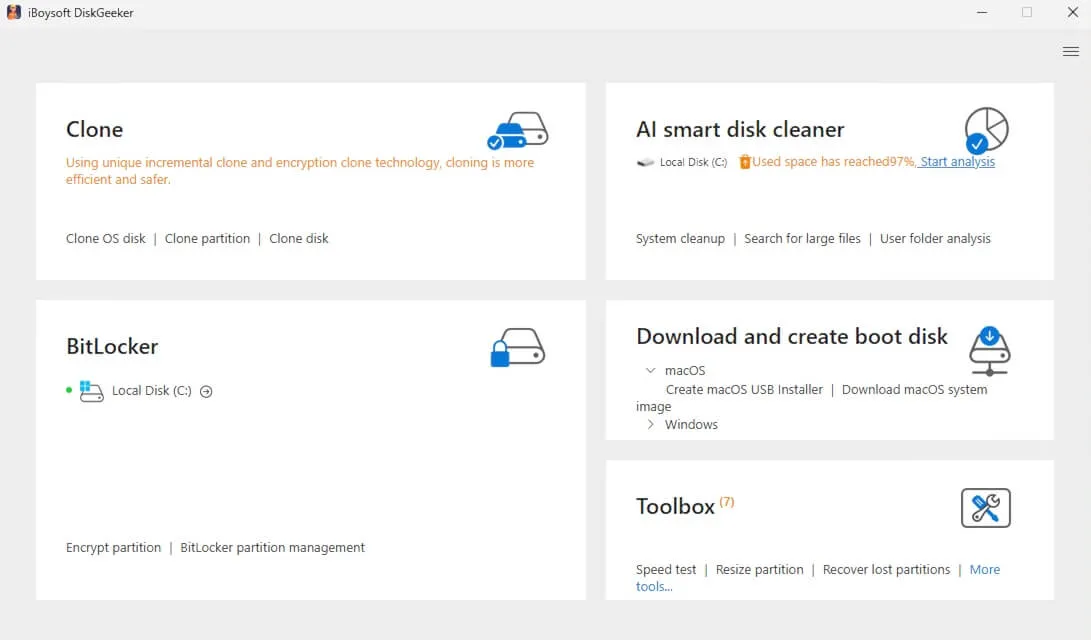
Step 3: Choose the needed macOS version and click Get.
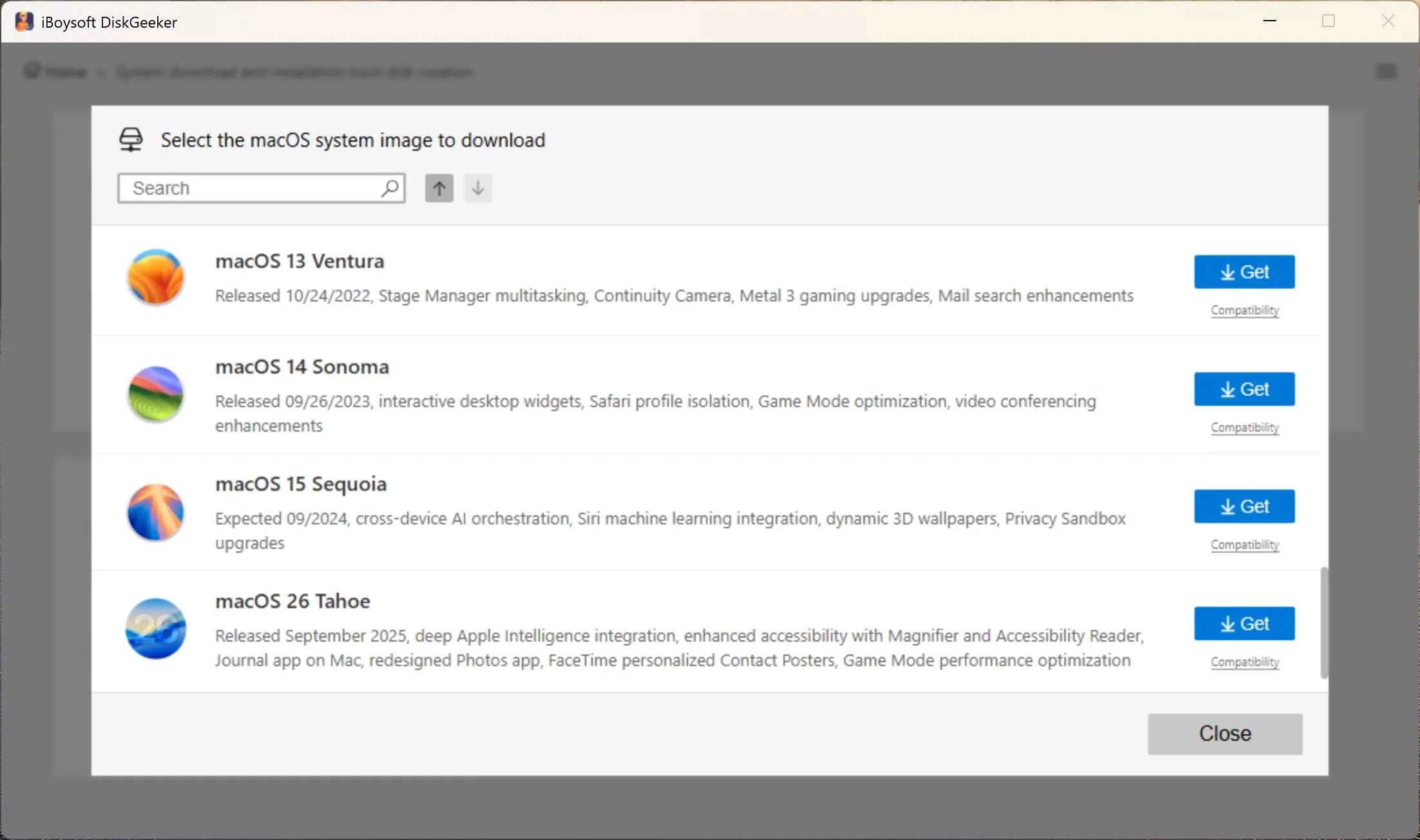
Step 4: Select the .iso format.

Step 5: Save the Mac OS ISO file to a desired location.

Reminder: If you need a macOS bootable USB installer, choose Create macOS USB installer in Step 2 instead.
Share this tool to benefit others!
Method 2: Create macOS ISO Files Manually Using Terminal (Advanced)
If you already have the macOS installer app on a Mac, you can manually create an ISO file using Terminal.
Requirements:
💻 A working Mac computer; ⬇️ macOS installer app; 💾 Sufficient disk space; ⌨️ Terminal access
- This method works if:
- ✅ You have a Mac that's compatible with the macOS version you need.
- ✅ You can deal with Terminal commands.
- ✅ You don't mind spending more time or facing potential errors.
Basic Workflow:
Step 1: Download the macOS full installer
To make the macOS ISO file, you'll need to download the macOS full installer first. For macOS High Sierra and later, you can get it from the App Store. For macOS Sierra and earlier versions, download the DMG file and then double-click to expand it until you install the macOS installer to the Applications folder.
Download the latest macOS Tahoe full installer here
Step 2: Make an empty ISO disk image in Terminal
Then you can proceed to create an empty disk image to accommodate the bootable USB installer. To do it, open Terminal and run the following command:
hdiutil create -o /tmp/Ventura -size 15979m -volname ISO -layout SPUD -fs HFS+J -type UDTO -attach
This command makes a new, 15979 MB disk image named "ISO," with the file system Mac OS Extended (Journaled) in the /tmp directory with the name "Ventura," and of the type suitable for creating CD/DVD ISOs.
If you're creating an ISO file of a different macOS, change "Ventura" to the desired system.
Step 3: Create a bootable macOS installer
To make the ISO file bootable, you'll also need to turn the macOS full installer into a bootable copy. Copy and paste the command for your macOS version and execute it in Terminal.
sudo /Applications/Install\ macOS\ Tahoe.app/Contents/Resources/createinstallmedia --volume /Volumes/ISOsudo /Applications/Install\ macOS\ Sequoia.app/Contents/Resources/createinstallmedia --volume /Volumes/ISOsudo /Applications/Install\ macOS\ Sonoma.app/Contents/Resources/createinstallmedia --volume /Volumes/ISO sudo /Applications/Install\ macOS\ Ventura.app/Contents/Resources/createinstallmedia --volume /Volumes/ISOsudo /Applications/Install\ macOS\ Monterey.app/Contents/Resources/createinstallmedia --volume /Volumes/ISOsudo /Applications/Install\ macOS\ Big\ Sur.app/Contents/Resources/createinstallmedia --volume /Volumes/ISOsudo /Applications/Install\ macOS\ Catalina.app/Contents/Resources/createinstallmedia --volume /Volumes/ISOsudo /Applications/Install\ macOS\ Mojave.app/Contents/Resources/createinstallmedia --volume /Volumes/ISOsudo /Applications/Install\ macOS\ High\ Sierra.app/Contents/Resources/createinstallmedia --volume /Volumes/ISO
sudo /Applications/Install\ OS\ X\ El\ Capitan.app/Contents/Resources/createinstallmedia --volume /Volumes/ISO --applicationpath /Applications/Install\ OS\ X\ El\ Capitan.app
The command runs with administrative privileges, requiring your account login password. Type the correct password (it won't echo to the screen) and press Enter to send it.
Step 4: Unmount the disk image and convert it into ISO
Once the macOS install media is created, unmount it and convert it from .cdr to .iso with the following commands (Replace Ventura with your macOS version):
hdiutil detach -force /Volumes/Install\ macOS\ Venturamv /tmp/Ventura.cdr ~/Desktop/Ventura.iso
⚠️ This method is error-prone and not recommended for inexperienced users.
Why We Don't Recommend Third-Party ISO Downloads
Third-party macOS ISO files often come with risks:
- Malware or modified system files
- Missing security patches
- Broken installation processes
- Incompatibility with modern Macs or VMs
Using official installers + verified tools ensures system integrity and long-term stability.
Final Verdict
If you need macOS ISO files, the safest approach is to download official macOS installers on a Mac and convert them properly. However, if you only have a Windows PC, download them directly with a reliable tool.
iBoysoft DiskGeeker simplifies this process by providing direct access to verified macOS installers without unsafe third-party downloads. It supports multiple macOS versions, reduces manual errors, and ensures system integrity. For both beginners and professionals, it is the most reliable starting point for macOS ISO creation.
If you want to learn more about the ISO file of each macOS version, check out the following guides:
Download/Create macOS Sonoma ISO File for VMware or VirtualBox
Download/Create macOS Ventura ISO File for VMware or VirtualBox
Download/Create macOS Monterey ISO for VirtualBox/VMware
Download/Create macOS Big Sur ISO for VirtualBox/VMware
Frequently Asked Questions
- QCan I download macOS ISO files directly from Apple?
-
A
No. Apple does not officially provide ISO files. They only distribute installer apps, DMG, or PKG files.
- QIs it legal to create macOS ISO files?
-
A
Creating ISO files from official Apple installers for personal use is generally acceptable under Apple's license terms.
- QCan iBoysoft DiskGeeker download older macOS versions?
-
A
Yes, when Apple still provides the installer, DiskGeeker can retrieve compatible versions automatically.
